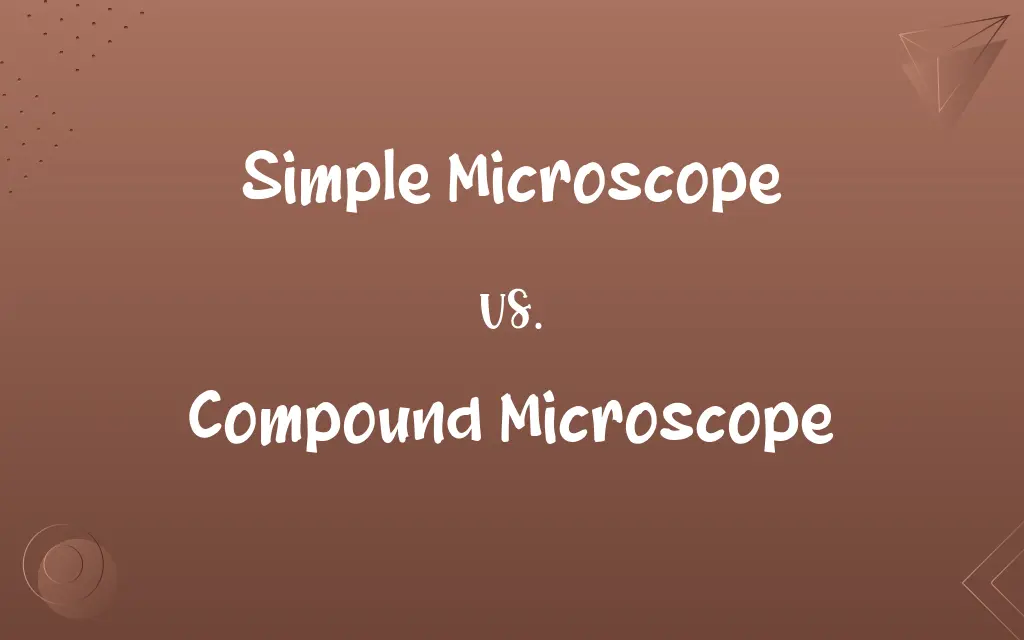Simple Microscope vs. Compound Microscope: Know the Difference

By Shumaila Saeed || Published on February 10, 2024
A simple microscope uses one lens for magnification, while a compound microscope uses multiple lenses for higher magnification.

Key Differences
A simple microscope, typically a magnifying glass, uses a single lens to enlarge objects, offering lower magnification. Conversely, a compound microscope consists of multiple lenses (objective and eyepiece lenses) that compound the magnification effect for detailed viewing of tiny structures.
Shumaila Saeed
Feb 10, 2024
The simple microscope is often portable, easy to use, and suitable for basic magnification needs. The compound microscope, with its intricate lens system and finer focus adjustments, is better suited for scientific and detailed study of microscopic entities.
Shumaila Saeed
Feb 10, 2024
With a simple microscope, the magnification power is limited, usually under 100x, making it ideal for examining larger, visible objects. The compound microscope, on the other hand, can achieve magnifications of 1000x or more, necessary for viewing cells and bacteria.
Shumaila Saeed
Feb 10, 2024
Simple microscopes require minimal maintenance and are typically more robust, making them suitable for younger users or fieldwork. Compound microscopes, with their delicate components, require careful handling and are commonly found in laboratories and educational settings.
Shumaila Saeed
Feb 10, 2024
In terms of illumination, simple microscopes often rely on ambient light. Compound microscopes, however, are equipped with their own light source, which is crucial for illuminating the much smaller specimens they are designed to observe.
Shumaila Saeed
Feb 10, 2024
ADVERTISEMENT
Comparison Chart
Number of Lenses
Single lens
Multiple lenses (objective and eyepiece lenses)
Shumaila Saeed
Feb 10, 2024
Usage
Basic magnification, larger objects
Detailed study, microscopic entities
Shumaila Saeed
Feb 10, 2024
Maintenance
Minimal maintenance, more robust
Requires careful handling, more delicate
Shumaila Saeed
Feb 10, 2024
ADVERTISEMENT
User Friendliness
Easier to use, suitable for beginners
Requires training, used by professionals
Shumaila Saeed
Feb 10, 2024
Applications
Educational, hobbyist use
Scientific research, medical diagnosis
Shumaila Saeed
Feb 10, 2024
ADVERTISEMENT
Simple Microscope and Compound Microscope Definitions
Simple Microscope
A portable device often used for rudimentary observation.
The students took simple microscopes on their field trip for quick observations.
Shumaila Saeed
Jan 12, 2024
Compound Microscope
A microscope with multiple lenses for high magnification.
The biologist used a compound microscope to study cell division.
Shumaila Saeed
Jan 12, 2024
Simple Microscope
A microscope with a single lens for basic magnification.
He used a simple microscope to examine the leaf's structure.
Shumaila Saeed
Jan 12, 2024
Compound Microscope
A tool with a finer focus, suitable for complex examinations.
Studying bacteria requires the precision of a compound microscope.
Shumaila Saeed
Jan 12, 2024
Simple Microscope
A magnifying tool ideal for young learners and hobbyists.
Her first simple microscope sparked a lifelong love of science.
Shumaila Saeed
Jan 12, 2024
Compound Microscope
An advanced microscope with its own light source.
The compound microscope's light illuminated the otherwise invisible specimens.
Shumaila Saeed
Jan 12, 2024
Simple Microscope
A basic optical instrument for enlarging visible objects.
A simple microscope is sufficient for viewing insects or stamps.
Shumaila Saeed
Jan 12, 2024
Compound Microscope
A sophisticated instrument for detailed microscopic analysis.
Compound microscopes are essential in modern medical laboratories.
Shumaila Saeed
Jan 12, 2024
Simple Microscope
A straightforward, user-friendly magnifying device.
He appreciated the simplicity of the simple microscope during his nature studies.
Shumaila Saeed
Jan 12, 2024
Compound Microscope
An optical device often used in scientific research.
Discoveries in microbiology are frequently made with a compound microscope.
Shumaila Saeed
Jan 12, 2024
Repeatedly Asked Queries
Can a compound microscope be used by beginners?
Yes, but it might require some basic training due to its complexity.
Shumaila Saeed
Feb 10, 2024
How does the magnification of a compound microscope compare to a simple one?
A compound microscope offers much higher magnification.
Shumaila Saeed
Feb 10, 2024
Are compound microscopes portable?
Less so than simple microscopes due to their size and delicacy.
Shumaila Saeed
Feb 10, 2024
Is a simple microscope suitable for professional research?
Generally no, it's more suited for basic or educational use.
Shumaila Saeed
Feb 10, 2024
What specimens can you view with a compound microscope?
Microscopic entities like cells, bacteria, and tissue samples.
Shumaila Saeed
Feb 10, 2024
What settings are compound microscopes typically found in?
Laboratories, medical facilities, and educational institutions.
Shumaila Saeed
Feb 10, 2024
What is the main use of a simple microscope?
For basic magnification of larger objects or as an educational tool.
Shumaila Saeed
Feb 10, 2024
Do simple microscopes have built-in light sources?
No, they usually rely on ambient light.
Shumaila Saeed
Feb 10, 2024
What maintenance does a compound microscope require?
Regular cleaning and careful handling to protect its delicate components.
Shumaila Saeed
Feb 10, 2024
Is a simple microscope effective for viewing cells?
No, cells are too small and require the higher magnification of a compound microscope.
Shumaila Saeed
Feb 10, 2024
Can a simple microscope achieve high magnification?
No, it's limited to lower magnification levels.
Shumaila Saeed
Feb 10, 2024
Is a compound microscope more expensive than a simple one?
Yes, due to its complexity and higher magnification capabilities.
Shumaila Saeed
Feb 10, 2024
Are there digital versions of simple microscopes?
Yes, there are digital magnifiers that function similarly to simple microscopes.
Shumaila Saeed
Feb 10, 2024
Can a simple microscope be used outdoors?
Yes, its portability makes it suitable for fieldwork.
Shumaila Saeed
Feb 10, 2024
How does ambient light affect the use of a simple microscope?
Adequate ambient light is necessary for clear viewing with a simple microscope.
Shumaila Saeed
Feb 10, 2024
How does the field of view compare between the two microscopes?
Simple microscopes have a wider field of view, while compound microscopes provide a narrower but more detailed view.
Shumaila Saeed
Feb 10, 2024
How is the image clarity in a compound microscope?
It's usually very clear and detailed, suitable for professional analysis.
Shumaila Saeed
Feb 10, 2024
Can a compound microscope be connected to a computer?
Yes, many modern compound microscopes can be connected for digital imaging.
Shumaila Saeed
Feb 10, 2024
Can you use a simple microscope for biological research?
It's not ideal for detailed biological research, which often requires higher magnification.
Shumaila Saeed
Feb 10, 2024
What education level is a compound microscope suitable for?
It's suitable for high school level and above, especially in scientific courses.
Shumaila Saeed
Feb 10, 2024
Share this page
Link for your blog / website
HTML
Link to share via messenger
About Author
Written by
Shumaila SaeedShumaila Saeed, an expert content creator with 6 years of experience, specializes in distilling complex topics into easily digestible comparisons, shining a light on the nuances that both inform and educate readers with clarity and accuracy.








































































